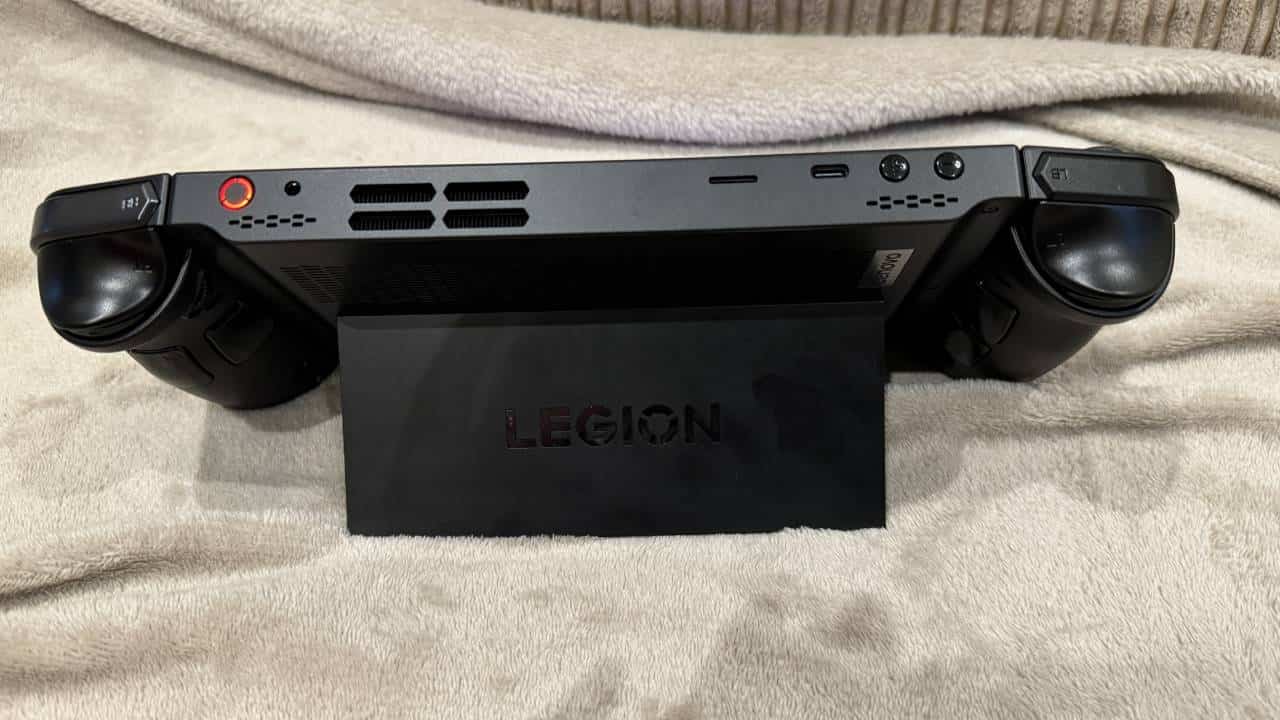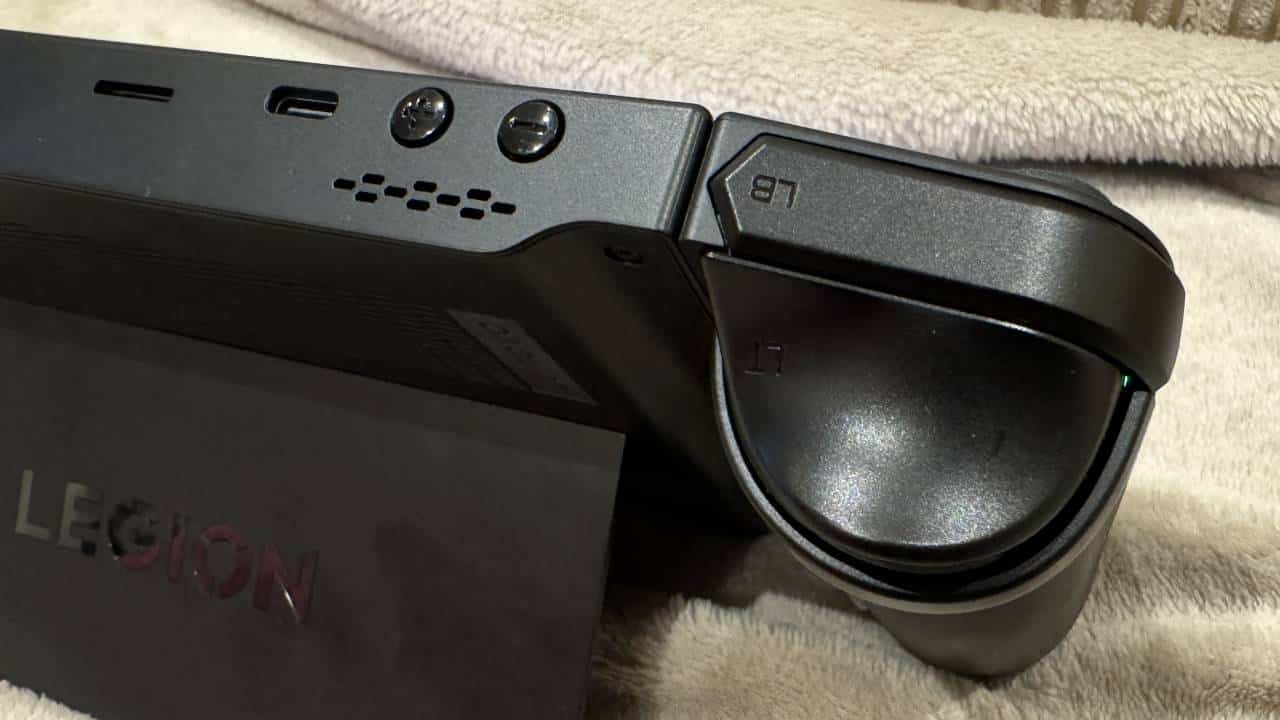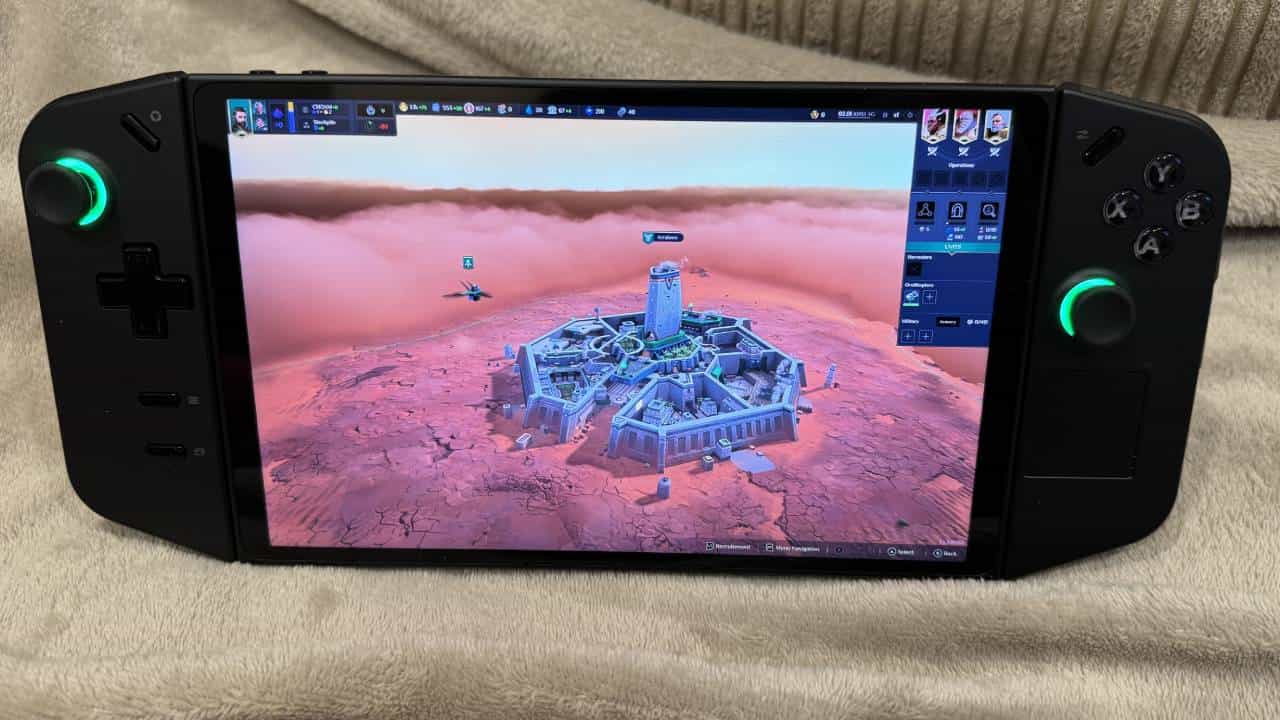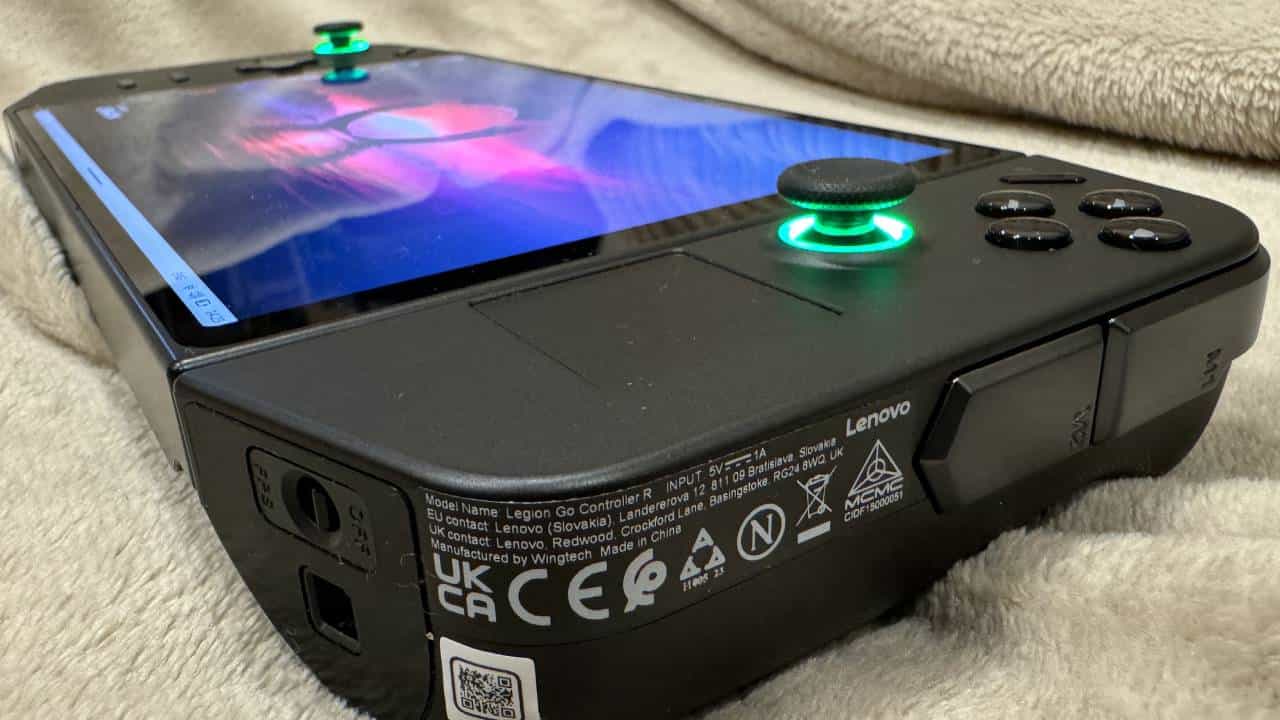Video Gamer is reader-supported. When you buy through links on our site, we may earn an affiliate commission. Prices subject to change. Learn more
- Powerful performance
- Large high resolution display
- All game stores available
- Adaptable quick settings
- Bulky and heavy
- Gets hot and loud
- Struggles in 1600p
- On the pricier side
The Lenovo Legion Go is the latest handheld gaming PC to emerge from a major manufacturer. Armed with some powerful specs, a large high resolution display, and some innovative ideas, this handheld has enough going for it in theory to compete with some of the best handheld games consoles. However, in execution, it falls short behind the competition in a few key ways proving that power isn’t everything.
As a PC enthusiast and someone who loves bleeding-edge component hardware, I can certainly respect the leaps that the Lenovo Legion Go is attempting to make. For the small minority of power users and tinkerers wanting the best possible settings this could be a stellar option, but for everyone else, you will have a better time with the Steam Deck OLED or the Windows-based ASUS ROG Ally instead.
Price and availability
The Lenovo Legion Go is available now in territories such as the US and the UK from major retailers and directly from the manufacturer starting at $699.99 / £699.99 for the 512GB model and $749.99 for the 1TB model. At the time of writing, the latter capacity does not appear to be available in the UK and Europe, but we’ll update you when this changes.
That positions the Lenovo Legion Go as the most expensive of the three mainstream portable gaming PCs with a price tag eclipsing the highest-end Steam Deck OLED and ASUS ROG Ally configurations. Specifically, Valve’s latest hardware revision in 1TB configuration sells for $649 / £569 and the Ally (featuring the same Ryzen Z1 Extreme APU) is now down to around the $599.99 / £549.99 mark.

Lenovo Legion Go
Design and features

In terms of its design, the Lenovo Legion Go takes heavy inspiration from the Nintendo Switch with its detachable wireless controllers and a kickstand which can prop the display up for tabletop use. There’s even an ‘FPS mode’ where you can dock the right controller to become a vertical-standing mouse. It’s a neat feature for sure and something you may rely upon more than may expect. That’s because this gaming handheld weighs in at a unsubtle 1.88 lbs (854g) with the controllers attached which can feel heavy in the hands after moderate use.
There’s no getting around the fact that the Lenovo Legion Go feels substantially heavier and bulkier in the hand than its rivals. Compare its weight to the competition with the ASUS ROG Ally and the nimbler weight of 1.34lbs (608 grams) and the Steam Deck OLED at 1.41 lbs (640g). That’s an increase of 40% when contrasting the two Windows machines against each other. Definitely on the heavier end of the spectrum as far as handheld machines go.
The added bulk is understandable when factoring in the larger display of the Go with a 8.8-inch IPS bonded 2560x1600p touchscreen. It’s armed with a 144Hz refresh rate as well as a peak brightness of 500 nits. There’s more real estate with the screen space than its competition with thin bezels against where the detachable controllers sit. I have no complaints about how the screen looks other than the fact that its peak brightness has since been overshadowed by the Steam Deck OLED’s 1000 nits and HDR, however, in isolation, it looks good.

Powering the Lenovo Legion Go is the AMD Ryzen Z1 Extreme complete with RDNA 3 integrated graphics. The Zen 4 APU is built upon a 4nm process with a 8-core (16 threads) CPU and a GPU with 12 CUs up to 2.7 GHz. This is the same chipset you’ll find in the ASUS ROG Ally, and it’s equally impressive here. There’s also 16GB LPDDR5X RAM clocked at 7500 MHz, so Lenovo hasn’t spared any expense in packing this handheld with powerful consumer-level handheld hardware. This is to be expected given its $700 / £700 starting price.
The controls should be quickly familiar to anyone who’s handled an Xbox controller with the same X-input button layout, asymmetric stick layout, and four-way D-pad. I should note that these are hall effect sticks which are said to last longer and alleviate drift thanks to their magnetic design as opposed to the more conventional electronic circuit-based variants. It’s a good choice on the manufacturer’s part given the potential thousand of hours of gaming you’ll be doing on this thing. Lenovo also included a singular trackpad on the right controller; it’s smaller and smoother than what you’ll find on the Steam Deck OLED, but appears to work the same way, an easier way to navigate the OS.
Speaking of the OS, the Lenovo Legion Go gives you the full Windows 11 experience for better and worse. For the bulk of your navigation, you’ll be relying on the touchscreen to use a virtual keyboard, launch programs, browse the web, etc. I ensured to manually install the latest drivers available from AMD and Lenovo to make sure my review unit had the best chance with compatibility, but more on that later. In terms of connectivity, there’s Wi-Fi 6E, Bluetooth 5.1, and you’ve got a 49.2Wh battery, all staples of upper-end handhelds in 2023.
Performance

What immediately stands out to me about the Lenovo Legion Go is its weight in the hand. Unlike my experiences with the Steam Deck OLED or the ASUS ROG Ally, I found holding this handheld for extended lengths of time to be uncomfortable, and this wasn’t helped by the bulk of the unit. I have large hands so navigating around with the controllers wasn’t too big of a deal, but I quickly found myself wishing the overall user experience was snappier.
This extends to using the Lenovo Legion Go in desktop mode to download new games, browse various games stores, and enjoy media playback. The singular trackpad works well enough for what it is, but its small size meant I was scrolling a lot more than I wanted to even when dialling up the mouse scroll settings in Windows to the fastest it could go. It never became natural and oftentimes I’d just touch the screen and hope for the best. Windows 11 isn’t designed for a display so small meaning I’d tap more than once for my inputs to register.
The manufacturer made an attempt to make a more familiar console overlay with the Legion Space, but this application is poor. In theory it should be great, a one-stop shop for all your game launchers in one place made for the Go handheld, but in execution, it’s little more than a middleman that opens desktop websites of launcher sites you can access easier through the likes of Google Chrome or Edge. It’s useful for quickly switching between the likes of Xbox Game Pass, GOG Galaxy, Steam and so on, but I’d avoid using it for anything else.

Gaming on the Lenovo Legion Go can be an excellent experience with its decent 1600p display, however, the Ryzen Z1 Extreme APU just doesn’t have enough power under the hood to deliver high-end gaming experiences in more demanding titles. Older games, like Fallout: New Vegas and indie titles like Hotline Miami run fine at the handheld’s native resolution in playable framerates, but for anything intensive you’re going to want to turn those settings down. It doesn’t help that the battery life is wildly inconsistent, lasting around an hour or two depending on game usage.
Fortunately, the manufacturer has thought of this and you’ve got an easy way to change the handheld’s native resolution of 2560×1600 to 1920×1200 and then 1280×800 with the press of a button which can be found on the right controller. From this menu you can also toggle from performance mode, set a fixed refresh rate, and change the thermal performance. You have the options at a glance to configure the settings as you need them, but for the bulk of my testing, I had all systems go to squeeze as much fps I could out of software.
Speaking of the games, let’s talk about how they play. Powerhouse titles such as Cyberpunk 2077 run anywhere from 15-29 fps at low settings when playing natively in 1600p. Straight away, I made the decision to dial down to 1200p, where the framerates were more stable around the 30fps mark, but the game was most comfortable at 800p with medium settings which hovered around the 45-60fps range. This was where I encountered the fact that changing the screen’s resolution in the settings menu doesn’t automatically adjust in the game, so every time I made a change, I had to open the game’s settings up and manually change the resolution. You can see the differences in the photos below.
Less demanding games, such as Hi-Fi Rush, Dune: Spice Wars, and Rollerdome played nicer with the increased resolution of the Lenovo Legion Go. With the handheld cranked out at max power settings, I was able to achieve around 60fps in 1200p, with 1600p dipping in and out around the 30fps mark depending on how intense the onscreen action was. Framerate drops and stutters were more common in the native resolution, so I found a happy medium with 1200p or dropped down to 800p where the framerates climbed to around 90fps or above, which is not too bad at all.
What was also apparently noticeable in my play testing was the heat generated by the device combined with the loudness of the fans when gaming moderately. Under heavy stress, the fans can become so loud that they drown out the audio of the game. You’re going to have to choose between high performance with loud fans and a serious hit to your fps, too. That’s because enabling “Quiet” mode with the fans and power saving straight up halves your performance in some games.
Some games wouldn’t work with the Lenovo Legion Go in my testing. After downloading the EA Play app in Xbox Game Pass to go through some Crysis Remastered, the game just refused to boot no matter how many restarts I did. There’s no real way of being able to know which games will definitely work, which may have issues, and those that are unsupported as you’ll find from the Steam Deck’s verification system. This essentially means it’s a bit of a gamble what games will provide playable experiences and which titles may struggle on the Lenovo Legion Go.

I also couldn’t shake the feeling that having to reduce the resolution down to 1280×800 kind defeats the point of the panel’s natively high resolution to begin with. Downscaling on a physically larger display made this resolution look blurry and less detailed because it wasn’t made with this resolution in mind from the jump. It’s not an issue I faced with the Steam Deck OLED as it’s made for 800p, and the Ally’s 1080p panel scales better in my experience.
Yes, it’s better for watching media and browsing the web, but these are things your smartphone can do easier, usually with higher resolutions and an OS made for touch control. More often than not, I found myself experimenting with the settings in the games I tested trying to get things exactly right than I did just kicking back with the game. The Lenovo Legion Go brings over both the good and the bad of the PC gaming experience where your mileage is going to vary.

Should you buy the Lenovo Legion Go?
The Lenovo Legion Go is an undeniably powerful handheld boasting a high resolution display and some innovative features, but it’s let down by the fact that it can’t comfortably game in 1600p without some serious compromises. The brand has made a valiant attempt to bring the full gaming laptop experience to a smaller form factor but with all the drawbacks that come with that. The battery life isn’t great, nor is the software, so at this point in time I can’t currently recommend this handheld for its asking price.
It’s made more frustrating given the pricing of the handheld which eclipses its competition and due to this factor, it’s not going to win the mainstream appeal. It’s more expensive than the similarly powerful ASUS ROG Ally and the easier to use Steam Deck OLED, these are the alternatives I recommend instead.




